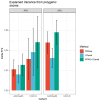Identification of 371 genetic variants for age at first sex and birth linked to externalising behaviour
- PMID: 34211149
- PMCID: PMC7612120
- DOI: 10.1038/s41562-021-01135-3
Identification of 371 genetic variants for age at first sex and birth linked to externalising behaviour
Erratum in
-
Publisher Correction: Identification of 371 genetic variants for age at first sex and birth linked to externalising behavior.Nat Hum Behav. 2021 Aug;5(8):1111. doi: 10.1038/s41562-021-01179-5. Nat Hum Behav. 2021. PMID: 34321615 No abstract available.
Abstract
Age at first sexual intercourse and age at first birth have implications for health and evolutionary fitness. In this genome-wide association study (age at first sexual intercourse, N = 387,338; age at first birth, N = 542,901), we identify 371 single-nucleotide polymorphisms, 11 sex-specific, with a 5-6% polygenic score prediction. Heritability of age at first birth shifted from 9% [CI = 4-14%] for women born in 1940 to 22% [CI = 19-25%] for those born in 1965. Signals are driven by the genetics of reproductive biology and externalising behaviour, with key genes related to follicle stimulating hormone (FSHB), implantation (ESR1), infertility and spermatid differentiation. Our findings suggest that polycystic ovarian syndrome may lead to later age at first birth, linking with infertility. Late age at first birth is associated with parental longevity and reduced incidence of type 2 diabetes and cardiovascular disease. Higher childhood socioeconomic circumstances and those in the highest polygenic score decile (90%+) experience markedly later reproductive onset. Results are relevant for improving teenage and late-life health, understanding longevity and guiding experimentation into mechanisms of infertility.
© 2021. The Author(s), under exclusive licence to Springer Nature Limited.
Conflict of interest statement
The main authors declare no competing interests. The views expressed in this article are those of the author(s) and not necessarily those of the NHS, the NIHR, or the Department of Health. MMcC (Mark McCarthy) has served on advisory panels for Pfizer, NovoNordisk and Zoe Global, has received honoraria from Merck, Pfizer, Novo Nordisk and Eli Lilly, and research funding from Abbvie, Astra Zeneca, Boehringer Ingelheim, Eli Lilly, Janssen, Merck, NovoNordisk, Pfizer, Roche, Sanofi Aventis, Servier, and Takeda. As of June 2019, MMcC is an employee of Genentech, and a holder of Roche stock.
Figures






References
-
- Lara LAS, Abdo CHN. Age at Time of Initial Sexual Intercourse and Health of Adolescent Girls. J Pediatr Adolesc Gynecol. 2016;29:417–423. - PubMed
Publication types
MeSH terms
Grants and funding
LinkOut - more resources
Full Text Sources
Miscellaneous

